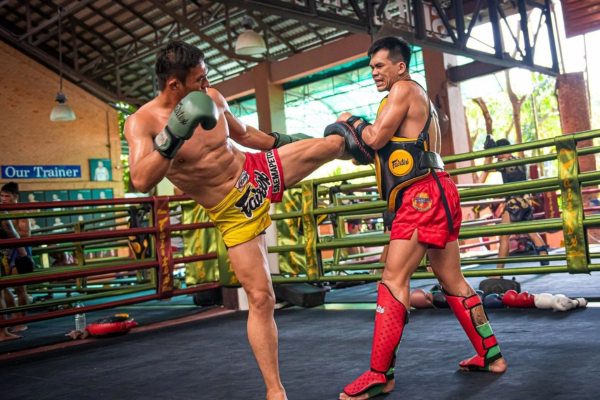Boxing gloves with Velcro vs. laces: Which is better and why?

When starting with boxing or kickboxing, choosing gloves might seem simple. But once you dive into the options, you quickly discover that not all gloves are created equal. One of the most fundamental differences lies in the glove closure: do you go for velcro or laces? This choice affects your performance, safety, and even how you experience your training. In this article, we break down the world of boxing gloves and help you determine which closure fits your goals, experience level, and style.
You’re ready to improve yourself. But the question is: with which gloves?
What’s the Difference Between Velcro and Lace-Up Gloves?

Velcro boxing gloves are built for convenience. They’re quick to put on and take off, perfect if you train alone or switch gloves frequently during workouts. The strap wraps around your wrist to give you decent support without needing help. That makes them popular among beginners, hobbyists, and people in group classes.
Lace-up gloves, on the other hand, offer a tighter and more precise fit. Since the laces wrap evenly around your wrist, they provide symmetrical support and hold everything in place. These gloves are ideal for serious fighters, sparring sessions, and official bouts. Just note: you'll need help putting them on. It takes more time, but the result is a glove that feels like a true extension of your hand.
Who Should Use Velcro Boxing Gloves?
For most athletes training at the gym, at home, or in group classes, velcro gloves are a practical and obvious choice. You can easily put them on by yourself—even with sweaty hands—and they stay secure during boxing or kickboxing. If you train several times a week, you’ll save literal minutes each session, and that adds up.
Velcro gloves also make it easier to switch between drills. One moment you're hitting pads, the next you’re working on the bag or doing partner work. That’s why they’re favored by beginners and recreational athletes looking for comfort, reliability, and simplicity. They also tend to be more affordable than lace-up gloves, making them an ideal entry-level option for new fighters.
Why Do Some Fighters Still Prefer Lace-Up Gloves?

Lace-up gloves are the gold standard in professional boxing and high-level sparring. The fit is unmatched—tight, stable, and even. This provides the best wrist support possible, which is critical when you’re throwing powerful punches or engaging in long training sessions.
There’s also a certain ritual to lace-up gloves. Putting them on requires focus, assistance, and a bit of ceremony. It creates a moment of preparation that encourages mental clarity and discipline. This sense of connection and precision is ideal for seasoned fighters who want to perfect every detail. And depending on the organization, lace-up gloves may be mandatory in official matches.
What Do the Experts Say?
Both research and real-world experience show that lace-up gloves distribute pressure more evenly around the wrist and forearm. This reduces the risk of injury, especially during powerful strikes or long training blocks. But that doesn’t mean velcro gloves are unsafe. As long as you choose quality and the correct size, both styles offer excellent protection.
Trainers and fighters agree: consistency is key. If your glove—velcro or lace—fits properly, is well maintained, and suits your body and technique, you’re good to go. Velcro gloves with dual strap closures, for example, come very close to the support that lace-up gloves provide.
What About the Price?
Generally, lace-up gloves are a bit more expensive, especially in the higher-end market. That’s because they’re meant for more demanding use and are often hand-crafted. But higher price doesn’t always mean better—what matters is that the glove fits your needs.
For the average athlete training two to three times per week, a quality pair of velcro gloves provides more than enough comfort, durability, and protection. If you're training intensively or preparing for competition, it's worth investing in a good pair of lace-up gloves that will grow with your skill level.
Frequently Asked Questions
A common question: can you tie lace-up gloves by yourself? In theory, yes—but in practice, it's difficult to tighten them evenly without help. That’s why most lace-up gloves are put on with assistance.
Another FAQ: are lace-up gloves safer than velcro? It depends on the context. For long sparring sessions or competition, laces often offer more wrist support. For day-to-day training, high-quality velcro gloves are usually more than enough.
Wondering what’s used in competitions? It depends on the rules of the federation or event. Amateur boxing often allows velcro, while professional fights typically require lace-up gloves.
What Fits Your Fighter’s Heart?
Choosing between velcro or lace-up gloves isn’t just about technique or price. It’s about your style, your training routine, and how you show up in the sport. Do you train independently, switch drills often, and prefer convenience? Then velcro gloves are your best sparring partner. Are you pushing hard, training for competition, or chasing perfection? Then lace-up gloves will match your level.
At Fightstyle, we’re here to help you make the right choice. We don’t just offer top-tier gear—we give expert advice tailored to your goals. Whether you’re just starting or aiming for the podium, your fighter’s heart deserves the right support.
Join the Fightstyle Family
Ready to find the perfect boxing gloves for your goals and training style? Browse our carefully curated selection of velcro and lace-up gloves. Our combat sports experts are happy to help with personal guidance.
Become part of the Fightstyle Family today—train injury-free, with confidence and joy.
 Nederlands
Nederlands English
English Deutsch
Deutsch Français
Français


Kan je veterhandschoenen ook gewoon gebruiken voor trainen op de bokszak, of is dat niet handig?
Leave a comment